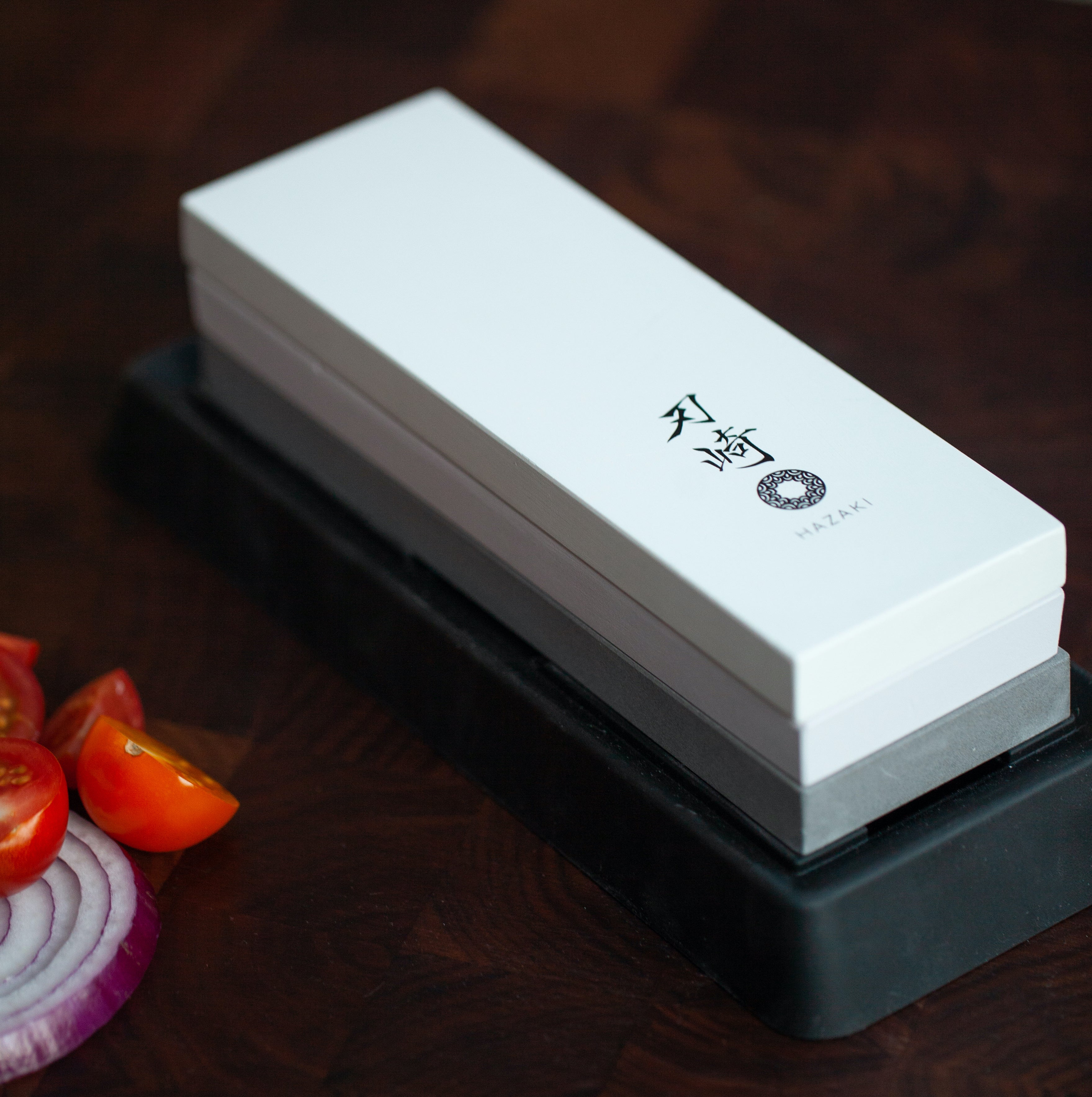Introducing the Hazaki
Guide on Whetstone Sharpening
Never own a dull knife again
Japanese whetstones are the absolute best way to sharpen kitchen knives.
Learning to sharpen with whetstones is a bit like learning to ride a bicycle. At first it can be frustrating. You might fall off a few times. But as soon as you get the hang of it, that’s it. You love it. And all your knives will be super sharp. Forever.
At Hazaki, we are on a mission to get everyone to experience the joy of using a quality Japanese kitchen knife. We believe that part of owning one is looking after it properly and keeping it sharp.
WHETSTONE GRITS
Decent Japanese ceramic whetstones make a big difference to sharpening. They produce better results AND make it easier to get those results. A hard stone works faster and is just as effective on harder steels such as those found in Japanese knives.
Like with sandpaper, coarser stones have larger abrasive particles and work faster. Finer stones have smaller particles and produce sharper edges. Whetstones are categorised as follows:
COARSE (#400 to #800 GRIT)
For grinding a new edge quickly onto a chipped or blunt knife.
MEDIUM (#1000 to #3000 GRIT)
Used after a coarse stone to make the knife sharper, or on their own for sharpening a knife that isn’t too blunt.
FINE (#3000 to #10 000 GRIT)
Used after medium to make the blade super-sharp.
The Hazaki Whetstone Kit is the only one in the world to offer the 3 different kind of grits all in the same kit.
COARSE
▿
MEDIUM
▿
FINE
HOW TO USE A WHETSTONE
If you follow the steps below, you shouldn’t go too far wrong:
1. CHOOSE YOUR WHETSTONE
Assuming your knife is starting blunt, select the coarse whetstone (#800) to use to grind a new edge onto your knife.
If it’s a knife you’ve sharpened before (so you won’t be changing the edge angle) and the knife doesn’t need too much work, you can start with the medium stone instead (#3000)
2. WET YOUR WHETSTONE
If you have a ‘soaking stone’, immerse it completely in water until the bubbles stop (about 5 minutes). If your whetstone is a ‘splash and go’ type, just splash some water on the surface.
The Hazaki Whetstone Kit is the only one in the world to offer the 3 different kind of grits all in the same kit.
3. SET YOUR ANGLE
You must set the correct ‘edge angle’ between blade and stone. For all Japanese knives, a 15 degree angle is recommended.
Then it’s important to keep the angle the same throughout the sharpening process. Not getting the angle right is perhaps the most common mistake.
4. START SHARPENING
Working with the stone upright on the bench, slide the knife up and down, grinding each section of the blade separately and pushing the blade down with two or three fingertips. This allows you to grind certain areas more than others (e.g. where there’s a chip or where you’re still trying to create a burr).
5. KEEP YOUR WHETSTONE WET
I keep a shot glass of water nearby for when the stone starts drying out. Make sure that stone is always wet.
6. RAISE A BURR
Key to using whetstones properly is to sharpen until you can feel a ‘burr’ on the opposite side of the blade from the one you are sharpening. This can take a good few minutes with a blunt knife. The burr feels like a wire running along the cutting edge, because that’s what it is. When you feel it appear, that’s when you know you have created a new edge. You need to keep sharpening until you can feel the burr along the whole length of the knife. When you’re trying to create a burr, sharpening one side only will help (go for the side of the dominant hand), as flip-flopping from one side to the other tends to make it fall off.
7. REPEAT ON THE OTHER SIDE
Repeat the process on the other side of the blade. Once you've created a burr on this side also, move to the next step.
8. REPEAT WITH FINER WHETSTONES
After having finished with the coarse whetstone, repeat the process with a medium whetstone. You should only need to work for about 1 minute each side. You can use the Ceramic Honing Rod afterwards to remove the burr and refine the edge.
9. DRY AND STORE YOUR WHETSTONES
Soaking stones can take up to two days to dry. Dry them properly before storing them to avoid moisture-related damage to the stone or the box.
We hope that you liked this reading! Feel free to contact us if you have any more questions.
Recommended articles
How to sharpen your knife with a honing rod
Browse our articles on knife sharpening to learn from scratch or hone your skills.
Hazaki's top sharpening products
We have created what we believe is the best range of sharpening products possible.




